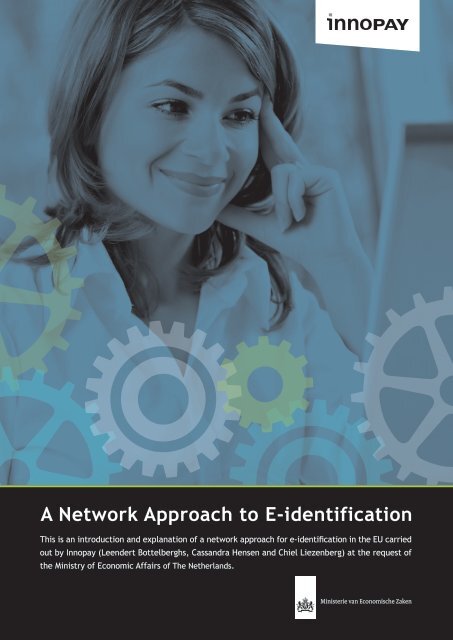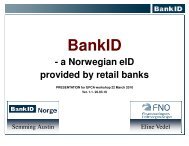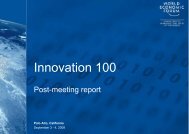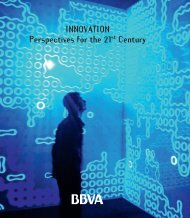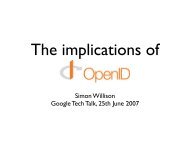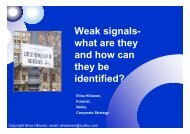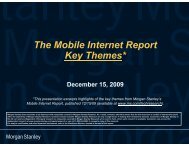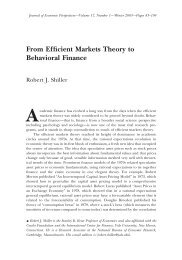A Network Approach to E-identification
A Network Approach to E-identification
A Network Approach to E-identification
- No tags were found...
You also want an ePaper? Increase the reach of your titles
YUMPU automatically turns print PDFs into web optimized ePapers that Google loves.
A <strong>Network</strong> <strong>Approach</strong> <strong>to</strong> E-<strong>identification</strong><br />
This is an introduction and explanation of a network approach for e-<strong>identification</strong> in the EU carried<br />
out by Innopay (Leendert Bottelberghs, Cassandra Hensen and Chiel Liezenberg) at the request of<br />
the Ministry of Economic Affairs of The Netherlands.
Contents<br />
Preface 4<br />
1 Management Summary 5<br />
2 Introduction 9<br />
2.1 Objective of this document 9<br />
2.2 ‘e-Recognition’: Beyond <strong>identification</strong> and authentication 9<br />
2.3 Outline of this document 10<br />
3 Importance and Urgency 11<br />
3.1 The need for electronic <strong>identification</strong> 11<br />
3.2 Lessons learned so far 13<br />
3.3 The way forward: A network approach 14<br />
4 A <strong>Network</strong> <strong>Approach</strong>: ‘E-ID as a Scheme’ 17<br />
4.1 Two-sided networks 17<br />
4.2 A scheme: Allowing both competition and cooperation 18<br />
4.3 Benefits of the 4-party model 24<br />
2
I<br />
5 Example of an E-ID Scheme 25<br />
5.1 Introduction 25<br />
5.2 End User 25<br />
5.3 E-service Provider 28<br />
5.4 Routing Service 29<br />
5.5 Authentication Provider 30<br />
6 Conclusion and Opportunities 31<br />
6.1 Conclusion 31<br />
6.2 Opportunities 32<br />
Terminology 34<br />
Publisher’s imprint 38<br />
3
Preface<br />
The users and providers of services on the internet need <strong>to</strong> be certain of the identity of<br />
the party they are dealing with. This is an essential condition <strong>to</strong> be met if our economy<br />
is <strong>to</strong> be able <strong>to</strong> conduct improved electronic business at both a national and an international<br />
level.<br />
The current methods used <strong>to</strong> identify service providers and users have their limitations.<br />
There are <strong>to</strong>o many different solutions that are often inconvenient, of limited scope,<br />
difficult <strong>to</strong> use and/or insufficiently secure. This jumbled ‘bunch of digital keys’ is<br />
causing problems: fraud is increasing, users are becoming distrustful, and the security of<br />
electronic traffic is declining. This is in turn hampering the further development of electronic<br />
business. Electronic business can and must be improved and made more sophisticated:<br />
it is time <strong>to</strong> take the next steps.<br />
This explora<strong>to</strong>ry study carried out by Innopay presents an appealing approach. Mobile<br />
telephones, bank cards and a variety of company systems can be used <strong>to</strong> sign a tax<br />
return, apply for a licence or deal with numerous issues on the internet – and all in<br />
a reliable manner. Consequently, no new solutions are introduced. Instead, the company<br />
proposes the use of existing systems <strong>to</strong> provide for the secure and reliable completion of<br />
transactions on the internet. This way, the existing solutions of a number of parties can<br />
be linked <strong>to</strong>gether in an open system.<br />
The Dutch government introduced DigiD several years ago - a means of authentication<br />
that enables the authorities <strong>to</strong> provide digital services <strong>to</strong> citizens. This was an important<br />
step forward. However, how <strong>to</strong> proceed In requesting this explora<strong>to</strong>ry study the Ministry<br />
of Economic Affairs makes a contribution <strong>to</strong> the discussion on the next steps. The business<br />
community and the major government service providers, in particular, urgently need<br />
<strong>to</strong> implement widely applicable and broadly supported solutions which guarantee that<br />
they know precisely who they are dealing with on the Internet. We have assigned this<br />
challenge a high priority.<br />
4
1<br />
Management Summary<br />
The recognition of users in digital environments is becoming increasingly challenging:<br />
the various parties involved in e-business and e-government have been struggling for<br />
many years with the lack of sufficient available options for the digital recognition<br />
of users. As all EU member states face adherence <strong>to</strong> the Services Directive by the end of<br />
2009, the need for a reliable e-identity solution is becoming urgent. This book presents<br />
a new approach <strong>to</strong> e-<strong>identification</strong> (e-ID) that could support pan-European interoperable<br />
e-<strong>identification</strong>.<br />
Several initiatives have been deployed, both at national as well as European level,<br />
<strong>to</strong> overcome the challenge of electronic <strong>identification</strong>. Some countries have implemented<br />
advanced and successful e-ID solutions within their borders, but all of the existing<br />
solutions lack full pan-European interoperability. In order <strong>to</strong> create an EU-wide<br />
recognition of electronic identity, two important initiatives were started. First, the ‘e-ID<br />
Roadmap’ outlines the European e-ID goals <strong>to</strong> be met by 2010 at a policy level and sets<br />
out specific objectives. Second, the STORK project aims at creating infrastructural interoperability<br />
by starting cross-border pilots and developing common rules and specifications<br />
for electronic authentication. In addition <strong>to</strong> the initiatives above, the EU is working<br />
on interoperability of the digital signature. The digital signature is, due <strong>to</strong> differences<br />
in implementation of the Electronic Signature Directive, not yet interoperable across<br />
Europe. ‘In January 2010 the European Commission has published a central list with links<br />
<strong>to</strong> national “trusted lists” of certification-service providers issuing qualified certificates<br />
in order <strong>to</strong> improve the interoperability of electronic signatures.’<br />
This report presents a network approach for creating a sustainable e-ID infrastructure.<br />
In this approach e-ID is regarded as a service in a two-sided network, instead of a<br />
technical infrastructure or a security problem. By applying a solution <strong>to</strong> e-ID that has<br />
proven its success in the electronic payments domain, a highly scalable and interoperable<br />
network can rapidly evolve due <strong>to</strong> low barriers in user acceptance. In the network<br />
approach <strong>to</strong> e-ID, End Users can make use of existing means of authentication <strong>to</strong> access<br />
all E-service Providers in the network (see figure 1-1).<br />
5
The End User perspective<br />
E-ID <strong>to</strong>day<br />
Netwerk approach <strong>to</strong> e-ID<br />
Bank<br />
Bank<br />
End<br />
User<br />
Utility<br />
End<br />
User<br />
Utility<br />
E-Gov<br />
E-Gov<br />
The End User can choose one key offered in the network and use it for <strong>identification</strong><br />
at all E-service Providers in the network<br />
Figure 1-1: The End User perspective of a network approach <strong>to</strong> e-ID infrastructure<br />
The E-service Providers in the e-ID network can each accept all the means of authentication<br />
issued in the network, <strong>to</strong> identify their End Users. As a result there is no need for them<br />
<strong>to</strong> issue these (costly) means of authentication themselves (see figure 1-2).<br />
The E-service Provider perspective<br />
E-ID <strong>to</strong>day<br />
Netwerk approach <strong>to</strong> e-ID<br />
End<br />
User<br />
End<br />
User<br />
End<br />
User<br />
E-service<br />
Provider<br />
End<br />
User<br />
E-service<br />
Provider<br />
End<br />
User<br />
End<br />
User<br />
E-service Providers can accept all means of authentication issued in the network<br />
<strong>to</strong> identify their End Users<br />
Figure 1-2: The E-service Provider perspective of a network approach <strong>to</strong> e-ID infrastructure<br />
6
The approach <strong>to</strong> realise this e-ID network is twofold. In the first place, this new e-ID<br />
solution consists of a decentralised 4-party model instead of a centralised 3-party model.<br />
In the e-ID network the issuing of means of authentication and the acquiring (routing)<br />
of these means are separated in two different roles (see figure 1-3). The 4-party model<br />
connects existing means of authentication or keys (e.g. cards, mobile phones, <strong>to</strong>kens,<br />
passwords) <strong>to</strong> E-service Providers. This way a level playing field is created in which<br />
various players and solutions can co-exist.<br />
Separated roles in a 4-party network<br />
E-ID <strong>to</strong>day<br />
Netwerk approach <strong>to</strong> e-ID<br />
End<br />
User<br />
E-service<br />
Provider<br />
End<br />
User<br />
E-service<br />
Provider<br />
End<br />
User<br />
End<br />
User<br />
End<br />
User<br />
E-service<br />
Provider<br />
End<br />
User<br />
E-service<br />
Provider<br />
Auth.<br />
Platform<br />
Auth.<br />
Provider<br />
Routing<br />
Service<br />
By separating the Authentication Provider role from the Routing Service role a 4-party<br />
model is created: this allows scalability of the network<br />
Figure 1-3: In an e-ID network Authentication Provider and Routing Service become separated roles<br />
Secondly, a set of agreements is made that describes and defines the roles of the different<br />
parties in the 4-party model. These agreements that ensure the interoperability of<br />
the network are referred <strong>to</strong> as a ‘scheme’. Parties that adhere <strong>to</strong> the scheme can join<br />
the e-ID network. This creates scalability of the network.<br />
7
The scheme entails a multidisciplinary set of specifications in three categories: business<br />
governance, application and infrastructure. A scheme basically addresses the ‘cooperative<br />
domain’ between participating parties, while at the same time creating a ‘competitive<br />
domain’ in which the parties can develop and offer their own propositions and<br />
products.<br />
This network approach <strong>to</strong> e-ID could also be used in the challenge <strong>to</strong> create cross-border<br />
interoperable e-ID models. The authorities’ role of the Member States in the design of<br />
such an e-ID scheme could primarily be related <strong>to</strong> the specification of the framework.<br />
The authorities can also continue <strong>to</strong> issue means of authentication and, at the same<br />
time, be a user of already existing means of authentication issued by commercial parties<br />
such as banks, telecom opera<strong>to</strong>rs and other <strong>to</strong>ken providers.<br />
The scheme can result in network effects combined with freedom of choice, market<br />
forces, free competition and innovation. This can result in rapid growth and a dynamic<br />
market. Currently this network approach is being deployed in The Netherlands, in the<br />
e-Recognition project where companies and their acting representatives are identified<br />
when doing electronic business with the authorities. The basic principles of this approach<br />
could be broadened from business-<strong>to</strong>-government, <strong>to</strong> citizen-<strong>to</strong>-government, business<strong>to</strong>-business<br />
and business-<strong>to</strong> consumer markets.<br />
8
2<br />
Introduction<br />
2.1 Objective of this document<br />
EU Member States are all undertaking efforts <strong>to</strong> adhere <strong>to</strong> the Services Directive 1 as<br />
adopted in 2006. The main challenge for Member States is <strong>to</strong> develop a solution that<br />
identifies users of online services with a high level of certainty. As a result, in several<br />
EU Member States initiatives are underway <strong>to</strong> secure electronic <strong>identification</strong> (e-ID) for<br />
public services. While this is a positive development, the inevitable diversity of these<br />
initiatives complicates cross-border use of secure e-<strong>identification</strong> systems. In short, there<br />
is a need for an interoperability framework <strong>to</strong> address e-ID requirements at an EU level.<br />
In this report a possible approach <strong>to</strong> e-identity developed by The Netherlands is explained.<br />
The approach is based on the principles used in several successful payment systems such<br />
as debit and credit cards and online payments. Their success was achieved by re-using<br />
existing infrastructures leading <strong>to</strong> high user acceptance. The Ministry of Economic Affairs<br />
of The Netherlands believes that this network approach <strong>to</strong> e-ID could provide a workable<br />
solution for the national e-ID challenge and possibly for cross-border e-ID in Europe<br />
as well.<br />
This document is of interest <strong>to</strong> policy and decision makers in the field of e-ID at both the<br />
national and European level, and <strong>to</strong> any person interested in e-ID solutions in general.<br />
2.2 ‘e-Recognition’: Beyond <strong>identification</strong> and authentication<br />
In the ongoing discussion regarding the subject of electronic <strong>identification</strong>, ambiguity<br />
about the terminology is still present. The introduction of organisations engaging in electronic<br />
transactions makes matters even more complex, since it is always a person that<br />
acts on behalf of an organisation. In order <strong>to</strong> be assured that the person carrying out<br />
the transaction is authorised <strong>to</strong> do so by the organisation, an extra verification has <strong>to</strong><br />
be carried out. In the Netherlands the concept of e-Recognition was introduced <strong>to</strong> cover<br />
this issue. Within this process extra information is obtained so that the relying party is<br />
assured that the transaction is valid. This can be regarded as extra services on <strong>to</strong>p of<br />
<strong>identification</strong> and authentication services.<br />
1 Directive 2006/123/EC of the European Parliament and of the Council of 12 December 2006 on services<br />
in the internal market<br />
9
Because the concept of e-Recognition is relatively new and can be carried out on <strong>to</strong>p of<br />
e-<strong>identification</strong> we will use the term e-identity throughout this document.<br />
This is also more in line with existing documentation addressing the subject and will<br />
avoid confusion for the reader. To avoid any confusion, we give our definitions of <strong>identification</strong><br />
and authorization as they are used within this document. Identification is generally<br />
defined as linking a set of specific data <strong>to</strong> a person <strong>to</strong> distinguish that person from<br />
other persons. Authentication is the verification of a claimed identity with the objective<br />
of recognising a person or user.<br />
2.3 Outline of this document<br />
In the next chapter the importance and urgency of a pan-European approach <strong>to</strong> e-ID is<br />
explained. The current situation in Europe with regard <strong>to</strong> the implementation of the<br />
Services Directive is given and lessons learned are identified. In Chapter 4 the basic principles<br />
of the network approach <strong>to</strong> e-ID are explained. Chapter 5 shows an example of<br />
how the network approach could work for cross-border e-ID. The final chapter provides<br />
the conclusions and opportunities.<br />
10
3<br />
Importance and Urgency<br />
3.1 The need for electronic <strong>identification</strong><br />
Both governments and businesses are offering more and more electronic services, aiming<br />
<strong>to</strong> increase efficiency and accuracy, reduce costs, and improve End User experience.<br />
With the increasing amount of services offered electronically, the need for reliable electronic<br />
<strong>identification</strong> is becoming more apparent.<br />
3.1.1 E-ID in the Netherlands<br />
In 2003 the Dutch government launched the ‘DigiD’ platform that enables <strong>identification</strong><br />
of citizens for online services. This solution made it possible for Dutch citizens<br />
<strong>to</strong>, for example, confirm tax registrations or claim unemployment benefits online.<br />
After experiencing a growing user base and successful usage in the past years, DigiD is<br />
facing several challenges for further growth:<br />
− Use is restricted <strong>to</strong> interaction with organisations with a public task.<br />
− Frequency of usage is low (on average 1.2 times a year) compared <strong>to</strong> other online<br />
services such as online banking or telephone, leading <strong>to</strong> many repeat requests for<br />
DigiD usernames and passwords.<br />
− Cost efficiency (cost per login) is difficult <strong>to</strong> attain as a result of low usage compared<br />
<strong>to</strong> high back office costs due <strong>to</strong> password resets.<br />
− Electronic <strong>identification</strong> does not meet the highest security requirements.<br />
− System is for domestic use (the Netherlands only).<br />
For communication at a higher security level, the Dutch government also enabled a Public<br />
Key Infrastructure (PKI) according <strong>to</strong> EU directives. This PKI, called ‘PKIoverheid’ uses<br />
Qualified Electronic Signatures and is available for both citizens and organisations in the<br />
Netherlands. It enables highly secure <strong>identification</strong> and verification in electronic communication,<br />
and can be used <strong>to</strong> e.g. digitally sign documents. Due <strong>to</strong> a lack of infrastructure<br />
that enables easy usage of this technology, the infrastructure is not utilised <strong>to</strong> its full<br />
potential.<br />
Another challenge is the use of electronic identities for transactions between government<br />
and businesses. In acknowledgement of these challenges the Ministry of Economic Affairs<br />
is searching for creative and innovative ideas <strong>to</strong> develop new solutions for electronic<br />
<strong>identification</strong>.<br />
11
3.1.2 E-ID in Europe: The Services Directive<br />
As the European community is striving for a closer relation between Member States and<br />
for social and economical prosperity, the development of a cross-border e-<strong>identification</strong><br />
framework is essential for the European economy. This need is emphasized by the European<br />
Commission (EC) through the Services Directive (2006/123/EC). The Services Directive<br />
aims <strong>to</strong> achieve a better internal market for enterprises by guaranteeing two freedoms:<br />
1) the freedom of establishment and 2) the freedom <strong>to</strong> provide services throughout the<br />
entire EU. It aims <strong>to</strong> eliminate the existing barriers <strong>to</strong> cross-border business, including<br />
administrative burdens, legislative uncertainty and lack of mutual trust. To be able <strong>to</strong><br />
achieve this goal, the Services Directive describes the following three main requirements<br />
<strong>to</strong> be met by each of the EU Member States:<br />
− Development of fair national requirements for enterprises.<br />
− Development of a single point of contact for enterprises.<br />
− Development of a solution <strong>to</strong> identify users (with a high level of security) of electronic<br />
services and <strong>to</strong> process requests of enterprises online.<br />
The latter requires a pan-European e-identity solution. The EC expects these deliverables<br />
<strong>to</strong> be in place in every Member State by December 2009.<br />
3.1.3 Europe on the road <strong>to</strong>wards securing electronic services<br />
Over the past decade, European Member States have developed e-ID systems that were<br />
best suited <strong>to</strong> their national needs. In recent years, efforts have been made at different<br />
levels <strong>to</strong> seek solutions for the European interoperability of these domestic e-ID solutions.<br />
Three main miles<strong>to</strong>nes have been reached 2 :<br />
− The e-ID Roadmap 3 .<br />
− The STORK project 4 .<br />
− The Services Directive.<br />
At a policy level, the e-ID Roadmap has been developed. This document outlines the<br />
European e-ID goals <strong>to</strong> be reached by 2010 and defines specific objectives. At the infrastructural<br />
level, the STORK project has recently been initiated.<br />
2 Report on the state of Pan-European eIDM initiatives, ENISA (2009)<br />
3 A Roadmap for a pan-European eIDM Framework by 2010, see<br />
http://ec.europa.eu/information_society/activities/egovernment/docs/pdf/eidm_roadmap_paper.pdf<br />
4 The ICT-PSP project Secure idenTity acrOss boRders linKed (STORK)<br />
12
This project is aimed at developing a series of pilot projects for several European countries,<br />
using the authentication means favored by the respective national governments.<br />
Both the e-ID Roadmap and the STORK project have a long-term scope.<br />
The Services Directive deadline of December 2009 is forcing the Member States <strong>to</strong> create<br />
functioning applications that require e-<strong>identification</strong> of users. Forced by this short-term<br />
deadline, the EC decided <strong>to</strong> make use of the electronic signature as a means <strong>to</strong> securely<br />
identify users. But, due <strong>to</strong> a lack of interoperability of the electronic signature between<br />
Member States, this has so far not resulted in a working cross-border solution.<br />
With the development of the e-ID Roadmap and the Services Directive, the EC has imposed<br />
ambitious short-term goals on itself and on the Member States. In addition <strong>to</strong> the STORK<br />
project and the electronic signature developments, this has resulted in even more relevant<br />
initiatives in the EU. The different solutions that Member States have developed form<br />
a knowledge base in the field of secure e-identity. Al<strong>to</strong>gether they have the potential <strong>to</strong><br />
act as a catalyst in furthering the desired e-ID interoperability in the EU.<br />
3.2 Lessons learned so far<br />
From both the EU and Member States’ initiatives (e-ID Roadmap and the STORK project),<br />
several lessons can be learned <strong>to</strong> ensure the successful implementation of a cross-border<br />
e-<strong>identification</strong> system in Europe.<br />
The e-ID Roadmap states that an interoperable e-ID infrastructure should ensure that<br />
administrations trust each other’s <strong>identification</strong> and authentication methods. With<br />
regard <strong>to</strong> the level of security, it further states that since several levels of secure authentication<br />
are needed, an e-ID solution should be multi-level. This way the authentication<br />
requirements for each electronic service can be tailored <strong>to</strong> the security needs of that<br />
service. Further the roadmap emphasises that a solution should enable private sec<strong>to</strong>r<br />
uptake. This allows Member States <strong>to</strong> rely on private sec<strong>to</strong>r partners (e.g. financial<br />
institutions) for the provision of e-ID services. Moreover this will enlarge the scope of<br />
the e-ID solution, not limiting it <strong>to</strong> government services alone. This widened scope may<br />
be necessary <strong>to</strong> ensure sufficient return on investment.<br />
13
From the experience with the Dutch DigiD solution, the use of the electronic signature and<br />
the other initiatives mentioned several additional lessons can be learned:<br />
− Uptake of any e-ID solution is largely dependent on the creation of trust and usability.<br />
This means that it should not only be safe, but also be perceived as such <strong>to</strong> meet the<br />
‘user friendly’ requirements, including privacy protection.<br />
− An additional aspect of user friendliness is the minimization of the ‘digital key ring’.<br />
This refers <strong>to</strong> the multitude of ‘digital keys’ that users obtain <strong>to</strong> identify themselves<br />
online at different services.<br />
− A sustainable cost structure is needed <strong>to</strong> finance the e-<strong>identification</strong> solution.<br />
Many governments now face high costs developing and maintaining e-ID systems<br />
themselves.<br />
− Consensus at the technical level of e-ID solutions is needed <strong>to</strong> create interoperability.<br />
− Scalability of the solution is required so it can be used by governments and enterprises<br />
in a broader geographical area.<br />
3.3 A network approach<br />
At this moment the EU and its Member States are at a crossroad concerning the development<br />
of pan-European e-ID solutions. It is clear that as of yet many solutions have enabled<br />
online <strong>identification</strong>, but no single initiative has provided the definitive solution <strong>to</strong> the<br />
European e-ID issues. The challenge is <strong>to</strong> combine the benefits of existing initiatives and<br />
integrate these in<strong>to</strong> an interoperable e-ID solution for Europe.<br />
The network approach as currently developed in the Netherlands aims <strong>to</strong> re-use existing<br />
means of authentication such as bank <strong>to</strong>kens, national e-ID cards and digital certificates.<br />
End Users can make use of these existing means of authentication <strong>to</strong> access all E-service<br />
Providers in the network. The End User perspective of the network approach <strong>to</strong> e-ID infrastructure<br />
is shown in figure 3-1.<br />
14
The End User perspective<br />
E-ID <strong>to</strong>day<br />
Netwerk approach <strong>to</strong> e-ID<br />
Bank<br />
Bank<br />
End<br />
User<br />
Utility<br />
End<br />
User<br />
Utility<br />
E-Gov<br />
E-Gov<br />
The End User can choose one key offered in the network and use it for <strong>identification</strong><br />
at all E-service Providers in the network<br />
Figure 3-1: The End User perspective of a network approach <strong>to</strong> e-ID infrastructure<br />
The E-service Providers that are part of the e-ID network can each accept all the means of<br />
authentication issued in the network <strong>to</strong> identify their End Users. This is shown in figure 3-2.<br />
The E-service Provider perspective<br />
E-ID <strong>to</strong>day<br />
Netwerk approach <strong>to</strong> e-ID<br />
End<br />
User<br />
End<br />
User<br />
End<br />
User<br />
E-service<br />
Provider<br />
End<br />
User<br />
E-service<br />
Provider<br />
End<br />
User<br />
End<br />
User<br />
E-service Providers can accept all means of authentication issued in the network<br />
<strong>to</strong> identify their End Users<br />
Figure 3-2: The E-service Provider perspective of a network approach <strong>to</strong> e-ID infrastructure<br />
15
To achieve this, a set of rules and agreements is created allowing parties <strong>to</strong> join<br />
the network as long as they meet the requirements. Since this approach is not a system as<br />
such, but rather a framework, it does not have one central node but allows for participating<br />
parties <strong>to</strong> communicate directly. Naturally this leads <strong>to</strong> interoperability and scalability,<br />
and it has several other benefits:<br />
− High End User friendliness: already known and trusted means of authentication<br />
are used.<br />
− No enlargement of the ‘digital key ring’.<br />
− Market participation is enabled, which means that it allows for the use of ‘digital keys’<br />
that are not issued by the public sec<strong>to</strong>r.<br />
− Cooperative creation and use of the infrastructure leads <strong>to</strong> a sustainable cost structure.<br />
− Multi-level: existing means of authentication already enable different security levels.<br />
In the next chapter the network approach <strong>to</strong> an interoperable e-ID solution will be<br />
presented and explained in more detail.<br />
16
4<br />
A <strong>Network</strong> <strong>Approach</strong>: ‘E-ID as a Scheme’<br />
The network approach we present in this document is not a new approach, but an existing<br />
solution applied <strong>to</strong> e-ID. It is based on the ‘scheme’ approach used in the past <strong>to</strong><br />
solve network and scale problems that arose with global payment networks. Currently<br />
this network approach is being developed in the Netherlands. To explain how this<br />
network approach can help <strong>to</strong> develop secure e-<strong>identification</strong>, we will start <strong>to</strong> explain<br />
the concept of the two-sided network and the basic elements of a scheme. Then we<br />
show how the concept of a scheme can be applied <strong>to</strong> create an e-ID scheme. In the last<br />
section we show what value added services the scheme concept can bring, in order <strong>to</strong><br />
meet existing needs and stimulate further innovation.<br />
4.1 Two-sided networks<br />
A two-sided network distinguishes two types of users that interact with each other, using<br />
a common infrastructure. Examples of two-sided networks can be found in the area of<br />
electronic payments, as for instance credit card networks. With credit card payments,<br />
consumers (cardholders) and merchants (acceptants) both use a common infrastructure<br />
that facilitates the transaction, while the two types of users have distinct requirements<br />
regarding the services that are offered <strong>to</strong> them. What they have in common is that they<br />
both benefit from the size of the other side of the network. In other words: cardholders<br />
benefit from the number of merchants that accept their card, and merchants benefit<br />
if many consumers hold the credit card that they accept. This is what is called a crosssided<br />
network effect 5 . In a network paradigm, electronic <strong>identification</strong> can be considered<br />
as a two-sided network with cross-sided network effects 6 .<br />
The evolution of global payment systems in the 1970’s was supported by the implementation<br />
of 4-party model schemes. The 4-party model implies that the two sides of the<br />
market, the consumer side and the merchant side, obtain their required services from<br />
different parties. These parties offer their services in competition with each other while<br />
giving the users access <strong>to</strong> the same network. This provides scalability, a competitive<br />
market and network effects. This is opposed <strong>to</strong> a 3-party model, where there is a single<br />
central party <strong>to</strong> which both consumers and merchants have <strong>to</strong> connect.<br />
5 Opposed <strong>to</strong> the cross-sided network effect is the same-sided network effect. This refers <strong>to</strong> the benefits<br />
gained from the growth of the same side of the network.<br />
6 Examples of international credit card schemes include Visa and MasterCard.<br />
17
For the 4-party model <strong>to</strong> work, a set of agreements is necessary that allows the participants<br />
<strong>to</strong> share a common infrastructure and offer the same basic services. This set of<br />
agreements is referred <strong>to</strong> as a ‘scheme’.<br />
4.2 A scheme: allowing both competition and cooperation<br />
So how did these schemes provide the fertile ground for these two-sided markets <strong>to</strong><br />
grow so successfully The strength of such a scheme lies in the separation of the cooperative<br />
and the competitive domain in the market. This way a scheme addresses two<br />
objectives of the network. Firstly, a scheme promotes cooperation between the parties<br />
by the creation of a joint infrastructure. This cooperative domain achieves a reduction<br />
of various costs (such as development and admission costs) resulting from the parties’<br />
collaboration in these fields. Secondly, the network promotes competition at the product<br />
level by offering market players an opportunity <strong>to</strong> distinguish themselves in terms of<br />
added value. This is the competitive domain were the parties involved can develop their<br />
specific propositions on <strong>to</strong>p of the joint infrastructure.<br />
The separation of the cooperative and competitive domains is essential <strong>to</strong> enable<br />
market competition and sort network effects. Moreover, since cooperation at the infrastructure<br />
level is manda<strong>to</strong>ry, this prevents competition between different infrastructures<br />
that raises cost and offers no extra benefits <strong>to</strong> End Users or participating parties<br />
in the network.<br />
4.2.1 Layers of a scheme<br />
A scheme consists of a set of agreements, rules and regulations that ensure the separation<br />
of domains. The cooperative domain of a scheme is primarily comprised of three<br />
layers:<br />
− Business and Governance: defining on what basis the participants in the scheme<br />
participate and their mutual rights and obligations in the scheme.<br />
− Application: defining the scheme’s scope, application and functionality.<br />
− Infrastructure: defining how participating parties communicate and exchange<br />
information.<br />
The competitive domain exists on <strong>to</strong>p of this collaborative domain as is shown in Figure<br />
3-1. The competitive domain now offers the participants in the scheme a level playing<br />
field in which they can develop propositions for the two-sided market.<br />
18
Participants<br />
& propositions<br />
Competitive<br />
– Rules & regulations<br />
Business/<br />
governance<br />
- Business model<br />
- Brand & licensing<br />
- Specification & certification<br />
- Legal aspects<br />
Application<br />
- Functionality<br />
- Semantics<br />
- Message standards<br />
- ...<br />
SCHEME<br />
Cooperative<br />
- Pro<strong>to</strong>cols<br />
Infrastructure<br />
- Connectivity<br />
- Security<br />
- ...<br />
Figure 4-1: Separation of domains in a scheme, broken down in<strong>to</strong> different layers.<br />
19
4.2.2 E-ID in a 4-party model<br />
Currently most e-ID models exist as 3-party models. Although this can function very well<br />
for certain markets, this model also has some limitations. The benefits of using a 4-party<br />
model over a 3-party model are discussed in paragraph 4.3.<br />
Within a 3-party model, the party that provides the central platform for the market can<br />
readily be split in<strong>to</strong> two roles <strong>to</strong> achieve the transition from a 3-party in<strong>to</strong> a 4-party<br />
model. This is shown in figure 4-2.<br />
Separated roles in a 4-party network<br />
E-ID <strong>to</strong>day<br />
Netwerk approach <strong>to</strong> e-ID<br />
End<br />
User<br />
E-service<br />
Provider<br />
End<br />
User<br />
E-service<br />
Provider<br />
End<br />
User<br />
End<br />
User<br />
End<br />
User<br />
E-service<br />
Provider<br />
End<br />
User<br />
E-service<br />
Provider<br />
Auth.<br />
Platform<br />
Auth.<br />
Provider<br />
Routing<br />
Service<br />
By separating the Authentication Provider role from the Routing Service role a 4-party<br />
model is created: this allows scalability of the network<br />
Figure 4-2: In an e-ID network Authentication Provider and Routing Service become separated roles<br />
20
In the 3-party model the central party both issues the authentication means and<br />
connects the (governmental) E-service Providers. In the 4-party model, the component<br />
that issues the authentication means is transformed in<strong>to</strong> an Authentication Provider, and<br />
the e-ID component linking the governmental E-service Providers is transformed in<strong>to</strong><br />
a Routing Service.<br />
A scheme with a 4-party network model ensures that all players have pure bilateral relationships<br />
and fulfil an explicitly specified role in the chain:<br />
– End User - E-service Provider: the End User concludes an agreement with an E-service<br />
Provider which requires the authentication of the End User. The authentication can be<br />
used for various purposes, such as secure login or digital signing (see paragraph 5.4 –<br />
Value added services for e-ID).<br />
– E-service Provider – Routing Service: the Routing Service offers the E-service Provider<br />
a connection <strong>to</strong> the network in order <strong>to</strong> obtain authentication of the End User.<br />
– Routing Service – Authentication Provider: the Routing Service and Authentication<br />
Provider exchange real-time messages and data during the authentication process.<br />
Within the e-ID scheme, all Routing Services are connected <strong>to</strong> all Authentication<br />
Providers.<br />
– Authentication Provider - End User: the End User has an account with an<br />
Authentication Provider. The End User can select his Authentication Provider for<br />
an authentication. The Authentication Provider will handle the authentication and<br />
return the result <strong>to</strong> the Routing Service.<br />
The roles played by the 4 parties in an e-ID model as a scheme are shown in figure 4-3.<br />
21
End User<br />
(person/entity)<br />
End User<br />
authenticates<br />
E-service Provider<br />
(government/corporate)<br />
End User<br />
applies means of<br />
authentication<br />
E-ID Scheme<br />
E-service Provider<br />
gets access <strong>to</strong><br />
infrastructure<br />
Authentication<br />
Provider<br />
(bank, CA, domestic<br />
e-ID solution)<br />
Real-time exchange<br />
of messages and data<br />
Routing Service<br />
(processor)<br />
Provisioning of authentication means<br />
Accepting authentication transactions<br />
Figure 4-3: The roles played by the 4 parties in an e-ID model as a scheme.<br />
The roles of the Authentication Provider and the Routing Service can each be filled<br />
in by multiple parties simultaneously. This gives the End User a choice where <strong>to</strong> obtain<br />
his authentication means. It could even be possible for the End User <strong>to</strong> have accounts<br />
at multiple Authentication Providers, as long as the scheme allows for this. The same<br />
applies <strong>to</strong> the E-service Provider who can choose where <strong>to</strong> obtain access <strong>to</strong> the e-ID<br />
network, since every Routing Service is connected <strong>to</strong> all Authentication Providers.<br />
The bilateral relationships between these parties are essential for the scalability<br />
of the network.<br />
22
A Scheme Management Organisation manages the rules and regulations. The manage<br />
ment of the brand of the e-ID solution can be part of the Scheme Management Organisation<br />
as well.<br />
Adopting this approach immediately results in a 4-party model that is ready for kick-off.<br />
Other solutions or parties can then be invited <strong>to</strong> play a role within the scheme if they<br />
comply with the scheme’s rules and regulations – thereby promoting further network<br />
effects.<br />
4.2.3 Management and governance of the scheme<br />
The authorities’ role in this scheme can be the initiation of the cooperation and assistance<br />
with the specification of the framework. However, the authorities do not need <strong>to</strong><br />
be the owners of the scheme. The most important motivation for authority involvement<br />
is <strong>to</strong> have influence on the functionality as well as oversight. Influence on functionality<br />
could be organised via a cus<strong>to</strong>mer reference board. Oversight could be organised<br />
through existing oversight bodies for example for telecom opera<strong>to</strong>rs or financial services.<br />
A variety of alternatives is conceivable in which the stakeholders receive an interest<br />
in the organisation managing the scheme. This will achieve broad support for the<br />
scheme. In addition <strong>to</strong> managing and possibly the further development of the scheme,<br />
this organisation also performs a number of other duties:<br />
the organisation issues licences <strong>to</strong> participants and certifies participants that are<br />
eligible for taking part in the scheme. The e-ID Scheme Management Organization<br />
is responsible for:<br />
− General management of the rules and regulations of the scheme.<br />
− Certification and licensing of Authentication Providers and Routing Services participating<br />
in the scheme.<br />
− Specification of commercial (model) agreements and, possibly, provide for the<br />
mutual settlement of accounts. This will depend on the chosen business model for<br />
the scheme.<br />
− Mediation in case of disputes that may arise between the Authentication Providers<br />
and Routing Services that cannot be settled bilaterally.<br />
− Product management of the common e-ID functionality offered by the network.<br />
This also includes further (functional) development of the scheme.<br />
− Brand management of the e-ID network. The e-ID scheme will be recognisable as<br />
a brand focussed on the End Users. This creates long-term trust and will help further<br />
growth of the network.<br />
23
4.3 Benefits of the 4-party model<br />
A 4-party model ensures the separation of the parties providing the services for the two<br />
sides of the network: the Authentication Provider serves the End User and the Routing<br />
Service serves the E-service Provider (see Figure 3-2). In the model, these two roles can<br />
now be played by different parties, which have the following benefits:<br />
− The model prevents the development of a centralised position of power.<br />
− The model allows the reuse of already existing means of authentication.<br />
− An End User can use one authentication means of choice <strong>to</strong> identify himself at<br />
multiple organizations resulting in high user friendliness and reduction of the ‘digital<br />
key ring’.<br />
− Use of the 4-party model will stimulate market development since the services on<br />
both sides of the network can be provided in competition.<br />
− Because of the infrastructural agreements in the scheme, the e-ID propositions developed<br />
in competition are always interoperable.<br />
− Since a common infrastructure is part of the scheme, the 4-party model prevents<br />
competition on an infrastructure level This prevents investment in different e-ID<br />
infrastructures that are not interoperable.<br />
− The 4-party model allows freedom of choice for all users of the e-ID network.<br />
The model ensures that every Routing Service is connected <strong>to</strong> every Authentication<br />
Provider and that these roles can be fulfilled by multiple parties simultaneously.<br />
This gives the End User the choice where <strong>to</strong> obtain his authentication means and it<br />
allows the E-service Provider <strong>to</strong> choose where <strong>to</strong> obtain access <strong>to</strong> the e-ID network.<br />
In general, the 4-party model scheme is an inclusive model that supports scale and<br />
interoperability.<br />
In the next chapter we will give an example of how a deployed e-ID Scheme could work<br />
for e-government services in a pan-European context.<br />
24
5<br />
Example of an E-ID Scheme<br />
5.1 Introduction<br />
In this chapter we present an example of how a deployed e-ID Scheme could work for a<br />
user in the EU. The intention of this example is <strong>to</strong> provide insight in<strong>to</strong> its operation and<br />
possible form. This example is neither definitive nor binding: it merely serves <strong>to</strong> illustrate<br />
the roles, the players and the processes involved in a cross-border e-ID process when e-ID<br />
would be organised in a scheme. The fictitious scheme, referred <strong>to</strong> as e-ID General, is<br />
based on the 4-party model presented in paragraph 4.2.2 and shows the operation of the<br />
scheme from various perspectives: End User, E-service Provider, Authentication Provider<br />
and Routing Service.<br />
5.2 End User<br />
A user that holds an account with an Authentication Provider (for example a participating<br />
bank which supports the e-ID General scheme), has an opportunity <strong>to</strong> use this as a means<br />
of authentication.<br />
Getting an e-ID General authentication involves the completion of a number of actions<br />
on internet pages displayed <strong>to</strong> the End User. We will present the example of a EU<br />
Member State End User that wants <strong>to</strong> register at the Chamber of Commerce of another<br />
EU Member State. Again this example is fictitious, but will show the user perspective<br />
on how a domestic authentication means is used <strong>to</strong> authenticate at any European<br />
e-government service.<br />
25
On the website of the Chamber of Commerce the End User fills in the forms that are<br />
necessary <strong>to</strong> register a company in that EU Member State. Once this is completed the<br />
user selects signing the registration using the e-ID General solution.<br />
The End User can now select an Authentication Provider from the list of participating<br />
parties that offer authentication means. In this example the user selects the bank he or<br />
she uses for internet banking, although several other types of Authentication Providers<br />
can participate, as long as they comply with the scheme requirements.<br />
26
The e-ID request for authentication of the user is now routed from the E-service<br />
Provider (in this example the Chamber of Commerce) via the Routing Service <strong>to</strong> the<br />
login screen of the selected Authentication Provider (in this example, the user’s bank).<br />
The user then follows the bank’s standard login procedure.<br />
The Authentication Provider displays the relevant request for authentication <strong>to</strong> the<br />
user. The request is authenticated using the standard procedure of the Authentication<br />
Provider. If the authentication succeeds then the response message is generated and...<br />
27
...the End User receives confirmation. The End User can now return <strong>to</strong> the website<br />
of the E-service Provider (the Chamber of Commerce).<br />
The E-service Provider immediately retrieves the result of the request for authentication<br />
via the Routing Service. The Authentication Provider (the bank) has issued confirmation<br />
<strong>to</strong> the End User. When the End User returns <strong>to</strong> the E-service Provider, the latter checks<br />
the integrity of the transaction result that has been received (the authentication), s<strong>to</strong>res<br />
it, and continues with the requested process or service.<br />
28
The process described above is just one example of an application of e-ID as a scheme.<br />
However, users will need <strong>to</strong> complete the same general procedure for other online<br />
processes.<br />
5.3 E-service Provider<br />
An E-service Provider wishing <strong>to</strong> accept the e-ID authentications will need <strong>to</strong> register<br />
with a Routing Service. Subsequent <strong>to</strong> registration (and further verification, as well as<br />
a risk analysis) the Routing Service will connect the E-service Provider <strong>to</strong> their system.<br />
To this end the E-service Provider will need <strong>to</strong> integrate the e-service application with<br />
the Routing Service’s platform. The necessary aids and support may be provided as part<br />
of the Routing Service offerings.<br />
Once connected, the E-service Provider can accept and process authentication requests<br />
of e-ID End Users. The E-service Provider is expected <strong>to</strong> retrieve the result of each transaction<br />
from the Routing Service immediately after the completion of requests for authentication.<br />
With a successful transaction this is the real time authentication.<br />
The E-service Provider can receive information at the level of individual authentication<br />
requests, and can also make use of any Routing Service’s supplementary services such as<br />
additional management information.<br />
In principle, E-service Providers can connect with more than one Routing Service.<br />
This opportunity can be of interest for a number of reasons, such as the distribution<br />
of risk (redundancy) and optimisation of the fees.<br />
5.4 Routing Service<br />
A Routing Service wishing <strong>to</strong> join the e-ID General scheme and develop and offer<br />
e-ID routing products in the scheme will need <strong>to</strong> register with the Scheme Management<br />
Organisation and obtain a Routing Service licence. To this end the Routing Service<br />
is issued a unique e-ID Routing Service ID for use in the network.<br />
The Routing Service offers routing products <strong>to</strong> E-service Providers. The Routing Service<br />
can design the Routing Service products as required, providing that they comply with all<br />
the conditions specified in the scheme documentation.<br />
29
The Routing Service can assign the performance of specific tasks <strong>to</strong> external parties (for<br />
example, an Acquiring processor 7 ).<br />
The Routing Service can use terms and conditions that are centrally specified (by the<br />
Scheme Management Organisation) <strong>to</strong> reach commercial and bilateral agreements with<br />
all Authentication Providers of the scheme. Alternatively, depending on the business<br />
model specified for the e-ID General scheme, this can also be done bilaterally between<br />
all Routing Services and Authentication Providers.<br />
5.5 Authentication Provider<br />
An Authentication Provider wishing <strong>to</strong> join the scheme and develop and offer e-ID<br />
authentication products for End Users will need <strong>to</strong> register with the Scheme Management<br />
Organisation and obtain an Authentication Provider’s licence. To this end the<br />
Authentication Provider receives a unique e-ID Authentication Provider ID for use in<br />
the network.<br />
Authentication Providers offer products <strong>to</strong> the End Users, in this example a means of<br />
authentication. The Authentication Provider can design the products as required, providing<br />
that they comply with all the conditions specified in the scheme documentation.<br />
The Authentication Providers can use terms and conditions that are centrally specified<br />
(by the Scheme Management Organisation) <strong>to</strong> reach commercial and bilateral<br />
agree¬ments with all Routing Services of the scheme. Alternatively, depending on the<br />
business model specified for the e-ID scheme, this can also be done bilaterally between<br />
all Authentication Providers and Routing Services.<br />
7 An explanation of ‘Acquiring processor’ is given in the Annex.<br />
30
6<br />
Conclusion and Opportunities<br />
In the previous two chapters we have explained the basic principles of how e-ID as<br />
a scheme could work. We described the benefits of the 4-party model approach and how<br />
this solution could work for a user. In this final chapter the most important findings are<br />
reiterated. Finally, some interesting opportunities that arise once a sound e-ID infrastructure<br />
is implemented are discussed.<br />
6.1 Conclusion<br />
The importance and urgency of sound e-ID solutions in Europe is undisputed.<br />
Many solutions already exist but unfortunately as of yet none of these solutions provide<br />
cross-border interoperability. The fictitious ‘e-ID General scheme’ as currently developed<br />
in<strong>to</strong> a business-<strong>to</strong>-government version in The Netherlands, addresses this challenge as<br />
a network problem. Its main difference from current e-ID models is the separation of<br />
the party issuing the means of authentication and the party routing e-ID transactions.<br />
This leads <strong>to</strong> a 4-party model that allows for endless scalability. All roles of the parties<br />
are described in a set of agreements, referred <strong>to</strong> as a scheme. All parties that adhere<br />
<strong>to</strong> the scheme can join the e-ID network. This model has a proven track record in global<br />
payment networks and could bring e-ID several benefits. The agreements assure the<br />
interoperability of the network and stimulate cooperation. E-service providers and End<br />
Users will have the freedom <strong>to</strong> choose their way <strong>to</strong> access the e-ID network: this will<br />
stimulate market competition leading <strong>to</strong> enhanced and innovative value added services.<br />
From the successful payments systems that apply this 4-party model we learned that<br />
the re-use of existing solutions provides a high user friendliness and low acceptance<br />
barriers. Al<strong>to</strong>gether this new approach <strong>to</strong> the e-ID challenge could be an interesting<br />
approach for pan-European interoperable e-ID solutions.<br />
31
6.2 Opportunities<br />
6.2.1 Application in adjacent spheres<br />
In this document, the e-ID solution is only regarded <strong>to</strong> be used by governmental<br />
E-service Providers. However, the need for reliable online authentication and <strong>identification</strong><br />
stretches out <strong>to</strong> the fields of business-<strong>to</strong>-business and business-<strong>to</strong>-consumer. An e-ID<br />
scheme can be broadened and used in business-<strong>to</strong>-business and business-<strong>to</strong>-consumer<br />
settings as well. The widening of the scope of an e-ID scheme exerts its influence on<br />
various other network issues:<br />
− An excessively broad scope results in additional complexity of the network.<br />
The number and complexity of the rules required for the appropriate management<br />
of the network will increase with the range of users and areas of application.<br />
This can have an impact on both the network and the level playing field.<br />
− An excessively narrow scope will impede the network effects. The gains available<br />
<strong>to</strong> the participants in the network will be limited and the network will not grow.<br />
This will exert an influence on the business case.<br />
Choosing the right scope for the application of the e-ID scheme will have a positive effect<br />
on the usage and growth of the network. While the scheme can initially be developed<br />
for e-government purposes, keeping in mind the broader application of the network<br />
is essential <strong>to</strong> reap its full potential.<br />
32
6.2.2 Value added services<br />
So far we have regarded e-ID as an abstract service. In reality, there can be various different<br />
services derived from secure authentication. In many European countries, there is a<br />
basic need for secure login <strong>to</strong> governmental websites and applications that hold valuable<br />
and privacy sensitive information. In addition <strong>to</strong> secure login, one could think of the<br />
following additional features for the e-ID network:<br />
− Single sign-on: this can help <strong>to</strong> facilitate transactions that involve multiple E-service<br />
Providers, where otherwise the End User would have <strong>to</strong> login multiple times.<br />
− Digital signing: the secure authentication means can be used <strong>to</strong> create electronic<br />
signatures, for example <strong>to</strong> enable document signing.<br />
− Attribute collection: the End User can authorise the collection of additional information<br />
about the person or entity, e.g. address, nationality.<br />
− Attribute verification: it is not always necessary <strong>to</strong> obtain personal information, but<br />
verification of a claimed (sub-)identity can be sufficient. A good example is age verification<br />
(e.g. is this person over 18).<br />
− Mandate management: within companies, employees act on behalf of their<br />
company when using specific electronic services. A company may want <strong>to</strong> delegate<br />
authorisations for the use of these services so that access <strong>to</strong> these services by can<br />
be managed efficiently.<br />
During the development of the e-ID scheme the value added services could be kept<br />
in mind. Decisions have <strong>to</strong> be made about features that are part of the core functionality<br />
(collaborative) and the services that could possibly be added <strong>to</strong> the proposition (competitive).<br />
Leaving room for additional services could stimulate innovation and further growth<br />
of the network.<br />
33
Terminology<br />
The use of the terms with the notes listed in the following table is applicable <strong>to</strong><br />
this document.<br />
TERM<br />
Account<br />
Acquiring processor<br />
Authentication<br />
(End User)<br />
Authentication<br />
Provider<br />
Competitive domain<br />
Cooperative domain<br />
NOTES<br />
The account maintained with an Issuer and Acquirer used<br />
for processing the transactions.<br />
A party that, within the scope of the e-ID scheme, can<br />
assume the responsibility for carrying out part or all of the<br />
transaction-processing duties of the Routing Service, under<br />
the overall responsibility of the Routing Service.<br />
Authentication is the term used for the verification of a<br />
claimed identity with the objective of recognising the user<br />
(such as a person or company). Authentication is based<br />
on the use of what are referred <strong>to</strong> as ‘means of authentication’.<br />
Examples of means of authentication in the real<br />
world include passports and driving licences. Other means<br />
of authentication are used in the electronic world, since<br />
the person involved has <strong>to</strong> be recognised by a computer<br />
system. Examples of means of authentication in the electronic<br />
domain include usernames and passwords, <strong>to</strong>kens,<br />
cards with PIN codes, as well as more complex forms such<br />
as ‘PKI cards’, which improve the reliability of the correct<br />
recognition of the user.<br />
A party that offers End User authentication means, which<br />
can be used online <strong>to</strong> prove a claimed identity. The<br />
Authentication Provider is also responsible for the enrolment<br />
of End Users.<br />
Part of the market where market parties compete, typically<br />
with their own service offerings enabled through a common<br />
infrastructure in a cooperative domain.<br />
Part of the market where market parties cooperate, typically<br />
<strong>to</strong> create a common infrastructure <strong>to</strong> enable competitive<br />
service offerings.<br />
34
TERM<br />
Digital signature<br />
End User<br />
E-recognition<br />
E-service Provider<br />
Identification<br />
NOTES<br />
When properly implemented the digital signature gives<br />
the receiver reason <strong>to</strong> believe the message was sent by<br />
the claimed sender. The legal consequences of the digital<br />
signature are implemented on a national level according <strong>to</strong><br />
the European Signature Directive. Within this context, the<br />
Qualified Electronic Signature (QES) is legally equivalent <strong>to</strong><br />
the handwritten signature.<br />
A person or entity (e.g. enterprise, government) that wants<br />
<strong>to</strong> use electronic services, and has <strong>to</strong> authenticate itself in<br />
order <strong>to</strong> do so.<br />
The process of electronically verifying whether a person<br />
acting on behalf of an organisation is granted by the organisation<br />
<strong>to</strong> do so in the context of a specific transaction, in<br />
combination with identifying the organisation itself.<br />
An institution (e.g. government) that offers online electronic<br />
services <strong>to</strong> End Users. Access <strong>to</strong> these services<br />
requires some form of electronic authentication.<br />
Identification entails linking a set of specific data <strong>to</strong> a<br />
person (the user) <strong>to</strong> distinguish that person from other<br />
persons. These persons can be both natural and legal<br />
entities. The set of specific data required for the unique<br />
<strong>identification</strong> of a person depends on the context: when,<br />
for example, an individual is <strong>to</strong> be distinguished than the<br />
citizen’s service number can be used. Enterprises can be<br />
distinguished by their unique Chamber of Commerce registration<br />
number.<br />
35
TERM<br />
Public Key<br />
Infrastructure (PKI)<br />
PKIoverheid<br />
Qualified Certificate<br />
Qualified Electronic<br />
Signature<br />
Routing Service<br />
Scheme<br />
Secure Signature<br />
Creation Device (SSCD)<br />
NOTES<br />
An establishment of architecture, technology, organisation,<br />
procedures and rules based on public key cryp<strong>to</strong>graphy,<br />
aimed at enabling reliable and secure electronic communication<br />
and electronic services.<br />
The Public Key Infrastructure (PKI) developed by the Dutch<br />
government: an infrastructure using qualified certificates<br />
<strong>to</strong> ensure secure <strong>identification</strong> of users, for example used<br />
<strong>to</strong> digitally sign documents.<br />
A certificate that is issued according <strong>to</strong> official national<br />
or European regulations by an official certificate service<br />
provider.<br />
An advanced electronic signature based on a qualified certificate<br />
and created by a secure signature creation device.<br />
A party that offers E-service Providers access <strong>to</strong> the e-ID<br />
network. To do so, the Routing Service is connected <strong>to</strong> all<br />
participating Authentication Providers.<br />
The whole of regulations governing the development and<br />
marketing of the defined product or services within the<br />
scheme. This also defines rules for market entry, as well as<br />
maintenance of the regulations itself.<br />
Device that can be used <strong>to</strong> place a digital signature in<br />
a secured way, meeting the criteria as outlined in the<br />
Directive 1999/93/EC of the European Parliament on a<br />
Community framework for electronic signatures.<br />
36
Publisher’s imprint<br />
Published on request of the Ministry of<br />
Economic Affairs.<br />
Authors<br />
Innopay:<br />
Leendert Bottelberghs<br />
Cassandra Hensen<br />
Chiel Liezenberg<br />
With special thanks <strong>to</strong> Bart Giesbers<br />
for reviewing this document.<br />
Design and layout<br />
www.myriaddesign.nl<br />
Copyright 2010 Innopay BV<br />
All rights reserved<br />
37


